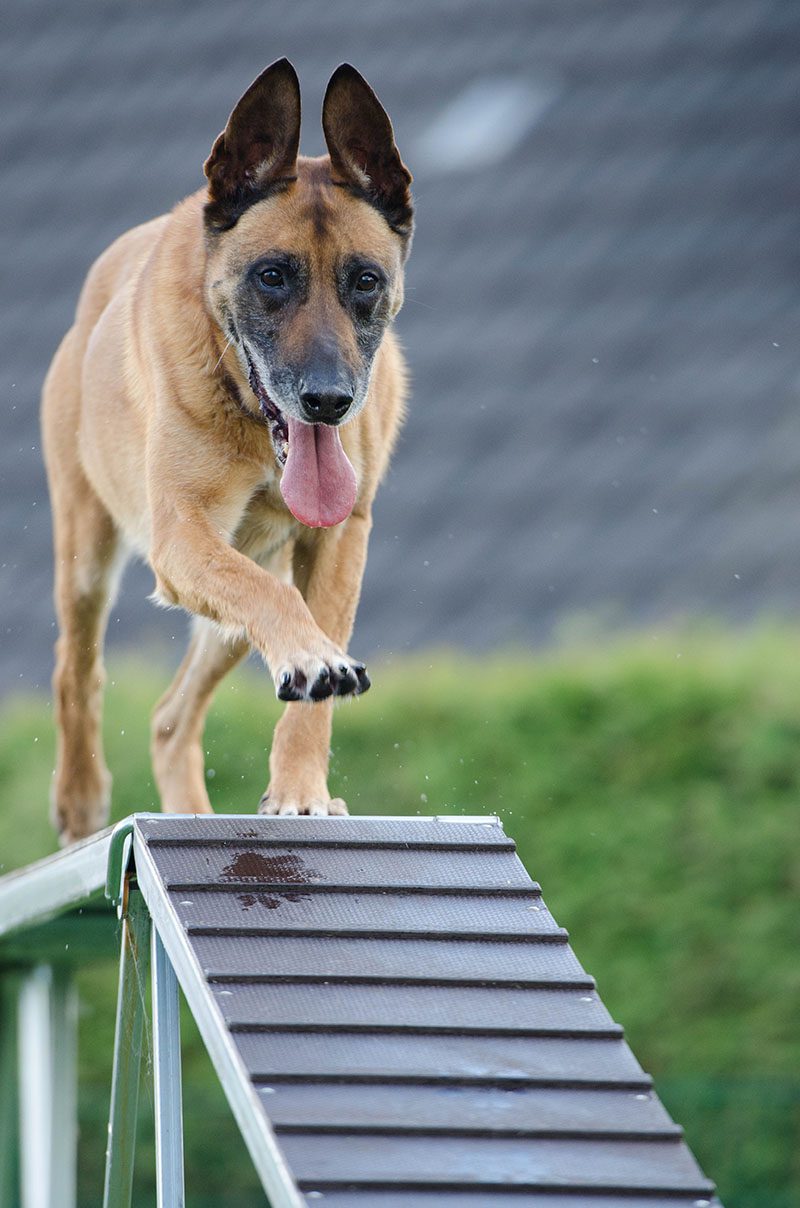
Understanding Electronic Collars for Dog Training
Electronic collars, also known as e-collars, remote training collars, or shock collars, are devices used in dog training to deliver electronic stimulation to the dog’s neck when a particular undesired behavior needs to be corrected. The adjustable stimulation levels can vary in intensity and duration, depending on the type of electronic collar used and the necessary level of correction. It is important to note that electronic collars should only be used after you’ve received proper instruction and the hands-on training provided by a professional dog trainer.
The idea behind e-collar training is to associate electronic stimulation with unwanted behavior, such as excessive barking or digging, so the dog learns to avoid that behavior in the future. The correction level is not intended to cause pain or harm to the dog but rather to get their attention and redirect their behavior. Remote training collars are potent tools that can help to train dogs effectively but should be used judiciously and responsibly.
Different electronic collars are available on the market, including remote-controlled collars, bark collars, and fence collars. Remote-controlled collars allow the owner or trainer to deliver the stimulation from a distance, while bark collars automatically provide stimulation when the dog barks excessively. Fence collars keep the dog within a particular area and deliver stimulation when the dog crosses the boundary. Choosing the correct type of e-collar technologies with adjustable shock levels for your dog’s specific needs is essential.

The Science Behind Electronic Collar Training
Electronic collar training is a form of operant conditioning, a behavior modification method that uses rewards and punishments to increase or decrease the frequency of a specific behavior. The electronic collar delivers a mild electric shock to the dog when it engages in undesirable behavior, such as barking excessively or jumping on people. The shock serves as a punishment, and the dog associates the shock with the dog’s behavior, eventually ceasing the behavior to avoid the penalty.
The science behind electronic collar training is based on classical conditioning. This is a type of learning where a neutral stimulus, such as a sound or a visual cue, is paired with a naturally occurring stimulus, such as food or pain. Over time, the neutral stimulus becomes associated with the naturally occurring stimulant and elicits the same response as the naturally occurring stimulus. In the case of electronic collar training, the shock serves as the naturally occurring stimulus, and the sound or visual cue serves as the neutral stimulus.
Research has shown that electronic collar training can be an effective method of dog training when used appropriately. However, it is essential to note that misuse of the collar can lead to negative consequences, such as fear, anxiety, and aggression in dogs. Dog owners must educate themselves on the proper use of remote collars and seek guidance from a professional dog trainer before using this training method.
Benefits of Electronic Collar Training for Dogs
Electronic collar training can be a versatile tool for dogs when used correctly. One of the main benefits is that it can improve communication between the owner and the dog. With electronic collars, owners can effectively give their dogs clear and consistent signals, helping them understand what is expected of them. This can result in less unsafe behavior, a better-behaved dog, and a stronger bond between the owner and the pet.
Another benefit of electronic collar training is that it can address specific behavior issues, from barking to food aggression. For example, if a dog tends to bark excessively, an electronic collar can discourage that target behavior. The collar can emit a warning tone, a mild shock, or continuous stimulation, which can help the dog learn to associate the barking with an unpleasant sensation. Over time, the dog stops barking altogether, resulting in a quieter and less stressful living environment for the dog and the owner.
Finally, electronic collar training can be a great way to keep dogs safe. For example, if a dog tends to run off or chase after things, an electronic collar can keep them within a safe distance. The owner can use the collar to signal the dog to return or discourage them from running after something dangerous. With proper use and training, electronic collars can be valuable for keeping dogs safe and well-behaved.

Types of Electronic Collars for Dog Training
Several types of electronic collars are available in the dog training market. One of the most popular types is the static shock collar which administers adjustable levels of a mild electric shock to the dog’s neck when the owner presses a button on the remote control. The static stimulation levels can be adjusted according to the dog’s size and temperament. Static shock collars stop unwanted behaviors such as barking, jumping, and digging.
Another type of electronic collar is the citronella collar which sprays a burst of citronella oil on the dog’s face when the owner presses a button on the remote. Citronella collars are used to discourage barking and other unwanted behaviors. The smell of citronella is unpleasant to dogs, and they quickly learn to associate the spray with their bad behavior.
Vibration collars are also an excellent option available in the market, which vibrate when the owner presses a button on the remote. Vibration collars train dogs that are hard of hearing or deaf and can’t respond to verbal commands. The dog feels the vibration, and the levels of vibration can be used to get their attention or to stop unwanted behaviors. Vibration collars are also helpful for training hunting dogs or dogs that work in noisy environments.
Features to Look for in an Electronic Collar
When choosing an electronic collar for your dog, there are several features you should look for to ensure safety and effectiveness. One important feature is the range of the collar, which determines how far away you can be from your dog and still deliver a signal. A more extensive range may be necessary for outdoor training, while a smaller range may suffice for indoor training. Choosing a collar fit with a range that matches your training needs is essential.
Another essential feature is the level of stimulation, which refers to the intensity of the signal delivered to the collar. Some collars offer a wide range of stimulation levels, while others have only a few. Choosing a collar with a stimulation level appropriate for your dog’s size, temperament, and training needs is essential. Additionally, some collars offer a vibration or tone-only mode, which can help train dogs sensitive to stimulation.
Water resistance is another important feature and an excellent choice for dogs, primarily if you use electric collars for an outdoor training program or in wet conditions. Look for a collar labeled as water-resistant or waterproof, and follow the manufacturer’s guidelines for proper use and care. Remember that not all collars are suitable for swimming or submersion in water, so be sure to choose a collar appropriate for your dog’s activity level and training needs.

How to Choose the Right Electronic Collar for Your Dog
When choosing an electronic collar as a training tool for your dog, you must first consider the type of collar that best suits your dog’s needs. Several electronic collars are available in the market, including vibration, shock, and citronella. Your kind of collar will depend on your dog’s temperament, size, and negative behaviors.
It is also essential to consider the range of the collar. If you plan to use the remote trainer for off-leash training, you will need a collar with a more extended range. On the other hand, if you plan to use the collar for basic obedience training, a shorter-range collar may suffice. Additionally, you should consider the number of levels of stimulation the collar offers. A collar with multiple motivation levels will allow you to tailor the training to your canine companion’s needs.
Lastly, it is vital to choose a collar that is durable and waterproof. Dogs can be rough on collars, so making the best choices in collar options that can withstand wear and tear is essential. Battery life falls into the durability category, and an option with rechargeable batteries will last longer than a cheaper model running off batteries you must change. Additionally, you will need a waterproof collar if you plan to use the collar for water activities, such as swimming or playing in the rain. Considering these factors, you can choose the suitable electronic collar for your dog’s training needs.
Preparing Your Dog for Electronic Collar Training
Before beginning electronic collar training, ensuring your dog is comfortable wearing a collar is essential. Start by gradually introducing your dog to the collar, allowing them to sniff and investigate it before putting it on. Once they are comfortable with the electric dog collar, start by putting it on for short periods while giving your dog treats and positive reinforcement to ensure a positive training experience.
Establishing a solid foundation of basic obedience commands and training before introducing the electronic collar is essential. Your dog should understand basic commands such as sit, stay, come, heel, and positive reinforcement training techniques. This will help your dog understand the purpose of the collar and make the training process smoother.
Before beginning electronic collar training, it is essential to consult with a professional dog trainer, training community, or behaviorist experienced with working on negative behaviors in dogs. They can help you understand the proper use and potential risks associated with electronic collars and provide training on properly introducing the collar to your dog. Additionally, they can help you define your training goals and develop a training plan tailored to your dog’s problematic behaviors and temperament.
Setting Up the Electronic Collar for Training
Before starting electronic collar training, it is crucial to ensure modern shock collars are correctly set up. The first step is to read the instruction manual thoroughly and familiarize yourself with the collar’s features and functions. Ensure the collar is fully charged before using it for the first time.
Next, adjust the electronic training collar to fit your dog. The collar should be snug but not too tight, with enough room for you to fit two fingers between the collar and your dog’s neck. The collar should also be adjusted for thicker coats to ensure the contact points make proper contact. It is essential to regularly check the collar’s fit, as dogs can lose or gain weight over time.
Once the remote dog training collar is fitted correctly, setting the correct stimulation level for your dog is essential. Begin with the lowest level and gradually increase intensity levels until you see a reaction from your dog. The proper levels of intensity delivered should be the minimum necessary to get your dog’s attention and motivate them to respond to your commands. Remember, the goal is not to hurt or punish your dog but to communicate effectively and reinforce positive behavior.
Basic Electronic Collar Training Techniques
To begin basic electronic collar training with your dog, it is necessary first to establish a positive association with the collar. Allow your dog to sniff and investigate the training dog collar before wearing it. Start by putting the collar on briefly and rewarding your dog with treats and praise. Gradually increase the length of time your dog wears the collar until they are comfortable wearing it all day.
The next step is associating the collar with a specific command or behavior. For example, when teaching advanced obedience commands your dog to come when called, use the electronic collar to reinforce the command. Start by calling your dog’s name and saying, “Come.” If your dog does not respond, use the electronic collar continuous button at a low-level electric stimulation setting to get their attention. When your dog responds after graduating through the levels of correction and comes to you, reward your furry friend with treats and praise.
Never using the electronic collar to punish or cause your dog pain is essential, and the collar should only be used to reinforce positive behaviors and commands. With consistent training and positive reinforcement, your dog will learn to respond to the electronic collar and readily obey commands.

Advanced Electronic Collar Training Techniques
Regarding advanced electronic collar training techniques, it’s important to remember that the collar should reinforce positive behaviors rather than punish negative ones. One technique is “escape training,” where the dog learns to stop a behavior from turning off a mild shock. This should only be used after the dog has learned the desired behavior through positive reinforcement.
Another technique is “boundary training,” where the dog learns to stay within an invisible fence around a particular area. This can be an invaluable tool for keeping a dog within a yard or away from certain areas of the house. The collar provides a warning beep or vibration mode if the dog gets too close to the boundary and a mild shock if they continue approaching it.
Finally, “distraction training” can teach a dog to focus on its handler in distracting environments. This involves using the collar to provide a warning tone or vibration when the dog looks away from their handler or becomes distracted and rewarding them when they refocus on their handler. This technique can be an incredibly effective tool for dogs who are easily distracted or have difficulty focusing in new environments.
Frequently Asked Questions About Dog Training Collars
Are electronic collars safe for dogs?
Electronic collars are effective training tools and safe for dogs when used correctly. It is essential to follow the manufacturer’s instructions and not use the collar for extended periods.
Can electronic collars be used for all types of dog training?
Shock collar training can be used for various purposes, including obedience training, behavior modification, and hunting training.
How do electronic collars work?
Electronic collars deliver a mild electric shock to the dog’s neck when the owner presses a button on a handheld remote control. The shock is meant to get the dog’s attention and redirect its behavior.
Do electronic collars hurt dogs?
The electric shock delivered by electric dog training collars is not meant to hurt the dog but to get their attention. The shock is similar to a static shock when the stimulation button is depressed and is not harmful to the dog.
Can electronic collars be used on puppies?
Using electronic training equipment on puppies under six months old is not recommended. Puppies are still developing and may not respond well to the collar.
How long should electronic collar training sessions last?
Electronic collar training sessions should be short, typically no longer than 10-15 minutes. Giving the dog breaks in between sessions is essential to prevent overstimulation.
Can electronic collars be used on aggressive dogs?
Electronic collars can be used with traditional training methods on aggressive dogs, but working with a professional trainer is essential to ensure the collar is used correctly and safely.
What should I do if my dog is not responding to the electronic collar?
If your dog is not responding to the electronic collar, it may be necessary to adjust the stimulation level and training modes or seek a professional trainer’s help. It is essential not to use the collar as a punishment and always to use step-by-step positive reinforcement and proper training techniques in conjunction with the collar.

